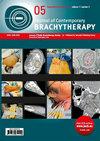Acute toxicity outcomes from salvage high-dose-rate brachytherapy for locally recurrent prostate cancer after prior radiotherapy
IF 1.1
4区 医学
Q4 ONCOLOGY
引用次数: 0
Abstract
Purpose:Isolated intra-prostatic recurrence of prostate adenocarcinoma after definitive radiotherapy presents a challenging clinical scenario. Salvage options require specialized expertise and pose risks of harm. This study aimed to present the acute toxicity results from using salvage high-dose-rate brachytherapy (sHDR-BT) as treatment in locally recurrent prostate cancer cases.
Material and methods:
Seventeen consecutive patients treated with sHDR-BT between 2019 and 2022 were evaluated retrospectively. Eligible patients had to have received curative intent prostate radiotherapy previously, and showed evidence of new biochemical failure. Evaluation with American Urological Association (AUA) and Common Terminology Criteria for Adverse Events (CTCAE) symptom assessments were performed for each case.
Results:
The median (inter-quartile range) age prior to salvage treatment was 68 (66-74) years. The median post-sHDR-BT follow-up time was 20 (13-24) months. At baseline prior to sHDR-BT, 8 (47%) patients had significant lower urinary tract symptoms. The median AUA score prior to sHDR-BT was 7 (3-18). Three (18%) patients reported irregular bowel function and 2 (12%) reported hematochezia prior to sHDR-BT. One-month post-treatment, the median AUA score was 13 (8-21, p = 0.21). Using CTCAE scoring, there were no cases of grade 2+ bowel or rectal toxicity, and no cases of grade 3+ urinary toxicity. Reported grade 2 urinary toxicities included 10 (59%) cases of bladder spasms, 2 (12%) cases of incontinence, 1 (6%) urinary obstruction, and 4 (24%) reports of urinary urgency. All these adverse events were temporary.
Conclusions:
This study adds to the existing literature by demonstrating that the acute toxicity profile of sHDR-BT is acceptable even without intra-operative magnetic resonance (MR) guidance or image registration. Further study is ongoing to determine long-term efficacy and toxicity of treatment.
高剂量率近距离放射治疗局部复发性前列腺癌的急性毒性结果
目的:前列腺腺癌在明确放疗后出现孤立的前列腺内复发是一种具有挑战性的临床情况。挽救方案需要专业的知识,并存在伤害风险。本研究旨在介绍使用挽救性高剂量率近距离放射治疗(sHDR-BT)治疗局部复发前列腺癌病例的急性毒性结果。符合条件的患者之前必须接受过治愈性前列腺放疗,并且有证据表明出现了新的生化治疗失败。对每个病例进行了美国泌尿外科协会(AUA)和不良事件通用术语标准(CTCAE)症状评估。结果:抢救治疗前的中位(四分位间)年龄为68(66-74)岁。SHDR-BT治疗后的中位随访时间为20(13-24)个月。在接受 sHDR-BT 治疗前的基线阶段,8 名患者(47%)有明显的下尿路症状。sHDR-BT 前的 AUA 评分中位数为 7(3-18)分。接受 sHDR-BT 治疗前,3 名患者(18%)报告肠道功能不规则,2 名患者(12%)报告血便。治疗后一个月,AUA 评分中位数为 13(8-21,p = 0.21)。根据 CTCAE 评分,没有 2 级以上肠道或直肠毒性病例,也没有 3 级以上泌尿系统毒性病例。报告的2级泌尿系统毒性包括10例(59%)膀胱痉挛、2例(12%)尿失禁、1例(6%)尿路梗阻和4例(24%)尿急。结论:这项研究补充了现有文献,证明即使没有术中磁共振(MR)引导或图像登记,sHDR-BT 的急性毒性也是可以接受的。目前正在进行进一步研究,以确定治疗的长期疗效和毒性。
本文章由计算机程序翻译,如有差异,请以英文原文为准。
求助全文
约1分钟内获得全文
求助全文
来源期刊

Journal of Contemporary Brachytherapy
ONCOLOGY-RADIOLOGY, NUCLEAR MEDICINE & MEDICAL IMAGING
CiteScore
2.40
自引率
14.30%
发文量
54
审稿时长
16 weeks
期刊介绍:
The “Journal of Contemporary Brachytherapy” is an international and multidisciplinary journal that will publish papers of original research as well as reviews of articles. Main subjects of the journal include: clinical brachytherapy, combined modality treatment, advances in radiobiology, hyperthermia and tumour biology, as well as physical aspects relevant to brachytherapy, particularly in the field of imaging, dosimetry and radiation therapy planning. Original contributions will include experimental studies of combined modality treatment, tumor sensitization and normal tissue protection, molecular radiation biology, and clinical investigations of cancer treatment in brachytherapy. Another field of interest will be the educational part of the journal.
 求助内容:
求助内容: 应助结果提醒方式:
应助结果提醒方式:


